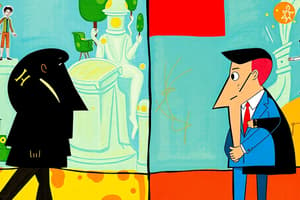Podcast
Questions and Answers
Which leadership style is characterized by minimal input from employees in decision-making?
Which leadership style is characterized by minimal input from employees in decision-making?
- Paternalistic
- Laissez-Faire
- Democratic
- Autocratic (correct)
What is a significant disadvantage of autocratic leadership?
What is a significant disadvantage of autocratic leadership?
- Promotes a clear chain of command
- Encourages collaboration among employees
- Quick decision-making
- Ignores creative solutions from staff (correct)
Democratic leadership allows employees to:
Democratic leadership allows employees to:
- Participate in the decision-making process (correct)
- Avoid taking responsibility for decisions
- Have no say in the leadership processes
- Follow strict orders from management
In which situations is autocratic leadership particularly effective?
In which situations is autocratic leadership particularly effective?
Which of the following best describes the role of a democratic leader?
Which of the following best describes the role of a democratic leader?
What is a key characteristic of democratic leadership?
What is a key characteristic of democratic leadership?
Which of the following is an advantage of democratic leadership?
Which of the following is an advantage of democratic leadership?
What is a major drawback of democratic leadership?
What is a major drawback of democratic leadership?
In which scenario is democratic leadership most effective?
In which scenario is democratic leadership most effective?
What can be a consequence of a paternalistic leadership style?
What can be a consequence of a paternalistic leadership style?
Which of the following describes the decision-making process in paternalistic leadership?
Which of the following describes the decision-making process in paternalistic leadership?
What is a potential issue with employee involvement in democratic leadership?
What is a potential issue with employee involvement in democratic leadership?
Which leadership style focuses on making decisions for the workforce?
Which leadership style focuses on making decisions for the workforce?
How does democratic leadership affect employee growth?
How does democratic leadership affect employee growth?
Who would be seen as an example of a democratic leader?
Who would be seen as an example of a democratic leader?
Flashcards
Autocratic Leadership
Autocratic Leadership
A leadership style where managers make decisions with little to no employee input.
Democratic Leadership
Democratic Leadership
A leadership style where employees participate in decision-making.
Autocratic Pros
Autocratic Pros
Clear chain of command, quick decision-making, suitable for stressful environments.
Autocratic Cons
Autocratic Cons
Signup and view all the flashcards
Democratic Style
Democratic Style
Signup and view all the flashcards
Democratic Leader's Persuasion
Democratic Leader's Persuasion
Signup and view all the flashcards
Democratic Leadership: Effectiveness
Democratic Leadership: Effectiveness
Signup and view all the flashcards
Democratic Leadership: Person Culture
Democratic Leadership: Person Culture
Signup and view all the flashcards
Steve Jobs: Democratic Leader?
Steve Jobs: Democratic Leader?
Signup and view all the flashcards
Democratic Leadership: Advantage 1
Democratic Leadership: Advantage 1
Signup and view all the flashcards
Democratic Leadership: Advantage 2
Democratic Leadership: Advantage 2
Signup and view all the flashcards
Democratic Leadership: Advantage 3
Democratic Leadership: Advantage 3
Signup and view all the flashcards
Democratic Leadership: Disadvantage 1
Democratic Leadership: Disadvantage 1
Signup and view all the flashcards
Democratic Leadership: Disadvantage 2
Democratic Leadership: Disadvantage 2
Signup and view all the flashcards
Paternalistic Leadership: Core Principle
Paternalistic Leadership: Core Principle
Signup and view all the flashcards
Study Notes
Types of Leadership Styles
- Different approaches exist for leading businesses, countries, teams, or groups
- Four main types include: Autocratic, Democratic, Paternalistic, and Laissez-Faire
Autocratic Leadership
-
Managers make decisions with minimal input from employees
-
Management dictates work methods and processes
-
Quick establishment of rules and policies
-
McDonald's is an example of an autocratic organization
-
Common in factories, fast-food businesses, and public services
-
Direct orders are expected to be followed
-
Employee views and opinions are disregarded
-
Suitable for environments needing clear direction
-
Effective in stressful or life-or-death situations
-
Advantages: Clear chain of command, quick decision-making, well-suited for environments needing clear directive leadership
-
Disadvantages: Negative impact on employee motivation, ignores creative solutions to problems, relies heavily on leader's competency, creates a culture of dependency
Democratic Leadership
-
Leaders involve employees in decision-making processes
-
Higher degree of employee participation and collaboration
-
Leaders decide which employees contribute to decisions
-
Richard Branson is an example of a democratic leader
-
Effective for creative companies
-
Encourages creativity and higher productivity
-
Advantages: Motivated employees, valued input, opportunities for growth, suitable for skilled employees
-
Disadvantages: Decision-making can take time, relies on employee skills and knowledge, potential for differing agendas among employees
Paternalistic Leadership
-
Leaders make decisions for employees, holding responsibility
-
Authority figure expects loyalty and trust
-
Employee welfare is considered when making decisions
-
George Cadbury is an example of a paternalistic leader
-
Suitable for low-skilled or inexperienced employees
-
Advantages: Loyalty from employees, low turnover, effective in environments with low-skilled workers
-
Disadvantages: Can demotivate employees if decisions are poor, doesn't leverage employee skills and knowledge, still dictatorial in nature.
Laissez-Faire Leadership
-
Employees carry out activities and make decisions freely
-
Relaxed environment with minimal direction
-
Leaders are responsible for decisions but offer little direction or guidelines
-
Suitable in creative industry, like artistic studios or high-tech environments
-
Decision-making happens quickly
-
Advantages: Suitable for creative environments and encourages employee growth, fostering innovation
-
Disadvantages: Lack of supervision may lead to poor productivity, can be perceived as avoidance of responsibility, potential for blame culture
Studying That Suits You
Use AI to generate personalized quizzes and flashcards to suit your learning preferences.




